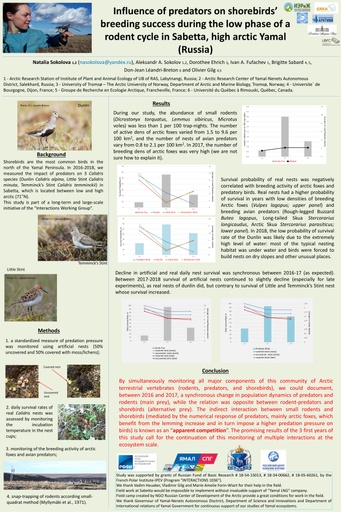pdf Influence of predators on shorebirds’ breeding success during the low phase of a rodent cycle in Sabetta, high arctic Yamal (Russia) Popular
3075 downloads

Natalya Sokolova
Arctic Research Station of Institute of Plant and Animal Ecology, Ural Branch, Russian Academy of Sciences, 629400, Zelenaya Gorka Str., 21, Labytnangi, Russia.
Aleksandr A. Sokolov, Arctic Research Station of Institute of Plant and Animal Ecology, Ural Branch, Russian Academy of Sciences, Labytnangi, Arctic Research Center of Yamal-Nenets Autonomous District, Salekhard, Russia Russia; Dorothee Ehrich, University of Tromsø – The Arctic University of Norway, Department of Arctic and Marine Biology, Tromsø, Norway; Ivan А. Fufachev, Arctic Research Station of Institute of Plant and Animal Ecology, Ural Branch, Russian Academy of Sciences, Labytnangi, Russia; Briggite Sabard, Universite´ de Bourgogne, Dijon, Groupe de Recherche en Ecologie Arctique, Francheville, France, Olivier Gilg, Universite´ de Bourgogne, Dijon, Groupe de Recherche en Ecologie Arctique, Francheville, France
Shorebirds are the most common birds in the north of the Yamal Peninsula. In 2016-2017, we measured the impact of predators on 3 Calidris species (Calidris alpine, Calidris minuta, Calidris temminckii) in Sabetta, which is located between low and high arctic (71°N). We implemented three methods: 1. a standardized measure of predation pressure was monitored using artificial nests (50% uncovered and 50% covered with moss/lichens); 2. daily survival rates of Calidris nests was assessed by monitoring the incubation temperature in the nest cups; 3. monitoring of the breeding activity of arctic foxes and predator birds. During our study, the abundance of small rodents (Dicrostonyx torquatus, Lemmus sibiricus, Microtus voles) was less than 1 per 100 trap-nights. The number of active dens varied from 1.5 to 9.6 per 100 km2, and the number of nests of predator birds was 0.8 and 2.2 per 100 km2 (2016 and 2017 respectively). Predation rates on artificial and real nests varied with breeding activity of arctic foxes and predator birds. In 2017 the high predation rate on “covered” (artificial) nests suggests that Arctic fox was the main predator of nests. This study is part of a long-term and large-scale initiative by the “Interactions Working Group”.

